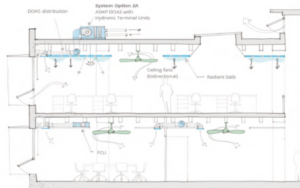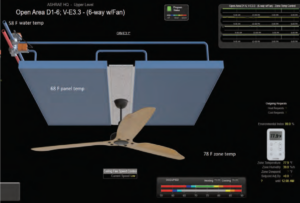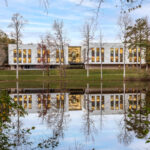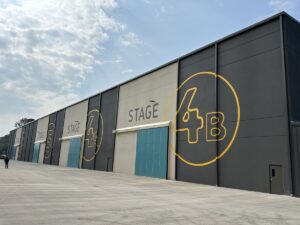Originally Published in Spring 2022 Special Issue of TAB Journal
Being a lifelong Atlanta sports fan first and a commissioning authority second, I am skeptical by default. As such, I loudly conveyed my pessimism when we were first approached about providing commissioning services for radiant cooling buildings. Our company, however, places sustainability at its core and aspires to work on challenging and ambitious projects, particularly in the Southeast.
The HVAC system designs on these projects often diverge from standard approaches deployed on most buildings due to low energy use targets. Southeastern climates require robust dehumidification to ensure adequate ventilation and comfortable indoor environments. Commercial buildings have used a variety of methods to provide dehumidification, but a common approach involves mixing air through air handling systems and rooftop units with chilled water or direct expansion cooling coils that perform cooling and dehumidification. A trend has emerged where ventilation air is separated from the main source of cooling and heating, generally via dedicated outside air systems (DOAS). DOAS units dehumidify the hot and humid summer air, then distribute it to localized cooling and heating systems, or directly to occupied spaces. Those localized units can include rooftop units, fan coil units, variable refrigerant flow cassettes, air handlers with reheat terminal units, etc.
Where does radiant cooling fit in? Using DOAS units to handle ventilation is helpful in dehumidifying, and, in my opinion, are a no-brainer for most Southeast buildings, but this approach does little to shrink the building’s energy footprint. We’re just moving the dehumidification burden. In order to make significant energy savings, more ambitious HVAC strategies must be explored. (It is important to consider the building enclosures as well, but that is for another day.)
Active and passive chilled beams, radiant heating and cooling floors, radiant heating and cooling ceiling panels – these HVAC strategies for localized temperature control can’t function in humid climates, right? The last thing we want is for the beams and floors to start sweating in the summer, causing it to essentially start raining inside.
This was certainly my concern. Could this work without the beams or the floors sweating in the summer? Perhaps, but was it worth the risk? Because the concept was relatively new in this climate zone, we weren’t presented with many successful examples from the few projects that had already implemented this.
However, we weren’t aware of any news articles reporting a massive indoor rain event at any highly regarded university in the Southeast. Due to the absence of evidence of major failures, the design teams we were collaborating with and the clients we were representing were ready to try this. As one client would regularly say, “we may not want to be bleeding edge, but certainly leading edge.”
Given that we routinely work for ambitious clients with strong sustainability goals, the opportunities presented themselves to work on these radiant cooling projects. But how do these radiant systems work? Radiant systems use surfaces to remove heat from the local heat sources, such as people or equipment. Radiant cooling is a sensible-only heat removal process, meaning no dehumidification occurs. Furthermore, radiant ceiling panels, floors, and chilled beams use elevated cooling water temperatures (55°- 60°F) in lieu of traditional chilled water temperatures (42°- 44°F) for cooling and dehumidification. Figure 1 below shows a graphical representation of decoupled ventilation plus radiant cooling, combined with ceiling fans for individualized comfort.
Figure 2 schematic below illustrates a combined system that integrates traditional chilled water supplying air handling units with mixing valves to create chilled beams that are elevated to provide chilled water. Radiant panels and flooring follow the same principle. The elevated temperature results in surface temperatures of 66°–70°F, which are ideal for controlling zone temperatures of 76°–78°F.
A zone-level illustration can be seen in Figure 3 below. Unlike traditional overhead variable air volume systems, radiant systems do not “throw” cold air on occupants. Radiant panels do not move any air, and active chilled beams experience some air movement, but the velocity is much slower. This method shifts a substantial portion of the sensible load work from the centralized DOAS units (and AHUs when applicable) to the local zones, reducing cooling capacity and ductwork and saving energy from fans as well.
Regardless of the approach, there is a possibility that these systems will fail, resulting in condensation on the panels, floor or beams. Proper control of these systems with fail-safes is essential. Each system option entails some degree of risk, but radiant cooling requires consideration of the controls strategy plus a capable test & balance agency and accompanying commissioning agent. This holds true of all modern HVAC systems as building energy codes continue to rapidly move HVAC design forward.
To see these strategies in action, let’s examine three different projects in the metro Atlanta area:
Figure 1: ASHRAE HQ HVAC Concept Design (credit: Integral Group)

The Kendeda Building for Innovative Sustainable Design at Georgia Tech is a ground-up construction totaling 38,000 ft.2 of conditioned space (See Figure 4 on page 24). The project was the first of its kind in Georgia to be certified under the Living Building Challenge (LBC) v3.1. The LBC is considered the most rigorous sustainability program in the world, and it requires a netpositive energy score. Because of this, HVAC system selection is critical. Here, the design team chose a DOAS unit for ventilation, plus radiant heated and cooled concrete slabs. The Kendeda Building’s radiant system uses two pumps, one as an injection pump (Pump A) and one as a circulation pump (Pump B), to adjust water temperature based on slab temperatures.
Figure 2: UGA STEM CHW Schematic (credit: Newcomb & Boyd)

Figure 3: ASHRAE HQ Typical Radiant Zone BAS Graphic (credit: Automated Logic)







